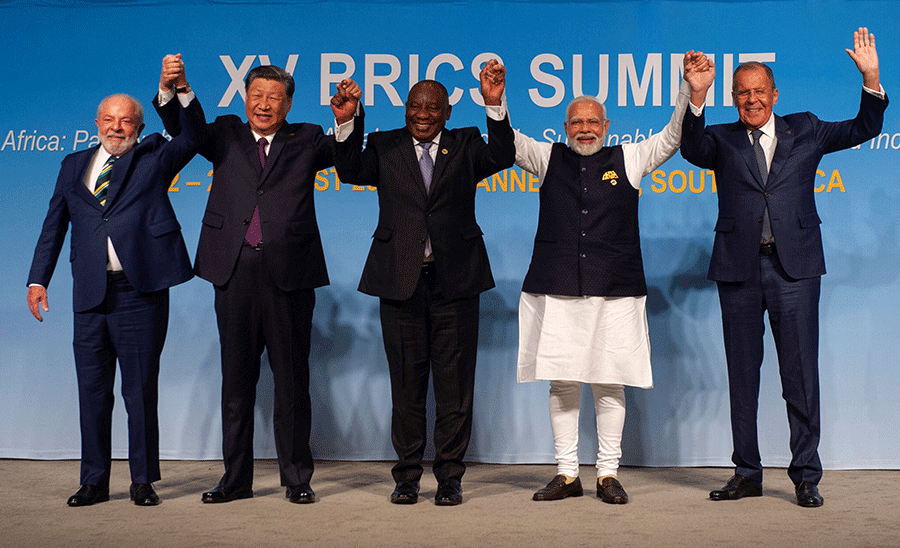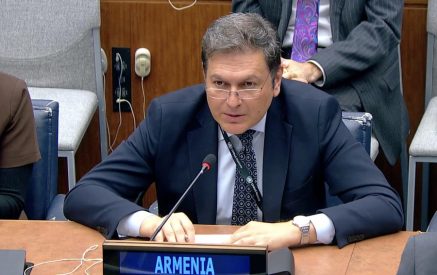by Yeghia Tashjian
After Armenia’s defeat in the 2020 Artsakh/Nagorno-Karabakh war and the shift of the geopolitical balance of power in the South Caucasus in favor of Azerbaijan, new external factors emerged that have shaped the future of the region. Some of these factors were related to geopolitical developments such as the war in Ukraine, the Indian-Pakistani rivalry, and the war between Israel and Hamas. Moreover, some geo-economic trends and the rise of new economic actors in the region had an impact on the political landscape. The expansion of BRICS (an intergovernmental organization comprising Brazil, Russia, India, China and South Africa) and competition over regional economic corridors have deepened cooperation, and sometimes mistrust, between local actors, as new alliances have emerged.
After Russia’s invasion of Ukraine, and the prolongation of the war of attrition between both sides, Russia became distracted from the developments in the South Caucasus. This gave Azerbaijan the opportunity to pursue its expansionist policy toward Armenia by engaging in military incursions on Armenian border villages, blockading the Berdzor (Lachin) Corridor connecting Artsakh and Armenia and completing the ethnic cleansing of the Armenians of Artsakh, amid the passive position of Russian peacekeeping forces. Moreover, the vacuum created by Russia pushed Turkey and Iran to engage in proactive foreign policy, as each tried to promote its security and economic interests in the region, often clashing or cooperating on many issues.
Read also
Russia’s inability to aid Armenia in times of need pushed Yerevan to diversify its security relations and seek help from other actors, such as India or France. The acquisition of arms from France raised certain concerns in Russia, as many analysts hinted that Armenia is in the process of leaving the Russian-led Collective Security Treaty Organization amid the deepening diplomatic crack between Moscow and Yerevan. Such a move would expose Yerevan’s vulnerability if a security alternative is not found that can protect Armenia against a new joint Baku-Ankara attack.
A second factor complicating regional politics is the conflict in South Asia between India and Pakistan. India has shown interest in the South Caucasus due to its backing of the International North-South Transport Corridor (INSTC) connecting Northern Europe and Russia to India via the Caucasus and Iran. Of course, containing the growing Turkish-Pakistani-Azerbaijani security axis is another concern for India, as New Delhi is wary that the political success of this axis can be replicated in other areas in the future, especially in Kashmir, where India and Pakistan are in conflict.
The recent arms deal between New Delhi and Yerevan must be viewed from this angle, as India is becoming an active player in the region. As clearly reflected in Indian media, Indian analysts and commentators argue that these arms deals have geopolitical components, as India aims to establish itself as a reliable defense partner globally and secure its regional interests by containing Pakistan and Turkey’s ambitions in the region. In this strategy of containment and aid to Armenia, Iran plays a crucial role. While Yerevan is unable to purchase Iranian weapons due to fear of the U.S. or Western reaction, Tehran is becoming a transit route for Indian weapons to reach Armenia.
The final external geopolitical factor is the Israeli-Iranian conflict, imported from the Middle East and the war in Gaza. Israel views the region from the prism of containing Iran. In this context, Azerbaijan is a key energy and security partner for Israel, as it supplies Tel Aviv with 40-percent of its oil needs and in return gets access to arms. Over the previous years, Israel has sold Azerbaijan ballistic missiles, drones, munitions and air defense systems. Meanwhile, Iran views Azerbaijani-Israeli security and military cooperation as a threat to its national security and territorial integrity and regards Armenia as a valuable partner in the region. Iran is also concerned about the realization of the “Zangezur Corridor.” Iran fears that the establishment of this Turkish-Azerbaijani-backed “extraterritorial corridor” through Armenia’s southern province Syunik could jeopardize Iranian interests by cutting the Armenian-Iranian border and threatening the Persian Gulf-Black Sea Corridor (also known as the North-South Transport Route), connecting Georgia to Iran via Armenia, which is viewed as an alternative road to the INSTC, connecting Iran to Russia via Azerbaijan’s railways and highways. Iranian officials and experts have occasionally called for the prevention of the establishment of a “NATO” or “Turanic” corridor connecting Turkey directly to Central Asia via Armenia. To ease the Azerbaijani pressure on Syunik, Iran has offered an alternative “corridor” (called the Aras corridor) connecting Azerbaijan proper to exclave Nakhichevan via its territories.
Meanwhile, the prolongation of the war in Gaza between Israel and Hamas may create new challenges or opportunities in the South Caucasus. As Israel is “sidelined” from the South Caucasus and distracted by war, this may push Azerbaijan to deepen its dependence on Russia, Turkey and Iran. In another scenario, Iran’s distraction from the South Caucasus or a possible direct clash between Tel Aviv and Tehran may turn the region into a new battlefront.
The expansion of BRICS and the competition over regional trade routes are also external geo-economic factors that need to be considered when assessing the current developments in the South Caucasus. Iran’s accession to BRICS is a win for Russia, India and China. Since former U.S. President Donald Trump withdrew from the JCPOA, the Iran nuclear deal, Moscow and Beijing have tried to integrate Iran into their regional architectures. Iran’s accession to BRICS will further facilitate regional interconnectivity projects within the context of the INSTC or other similar projects. This could also make the bloc attractive for Armenia and Azerbaijan in the future.
There are two major trade corridors passing via the South Caucasus—the Russian and Iranian-backed INSTC and the Turkish-backed “Middle Corridor.” In addition to their geo-economic background, these corridors also have geopolitical weight, as each regional actor tries to extend its economic and political influence beyond the region by facilitating regional trade interconnectivity. The South Caucasus is at the crossroads of these corridors, where the geo-economic interests of regional actors clash and intersect.
For Russia, after its invasion of Ukraine, the South Caucasus became its only gateway to the Middle East and new developing markets. If the INSTC becomes operational, and if in the future Syria is linked to Iran via Iraq, then Russia for the first time would have direct land access to its military port in Tartous on the Syrian coast of the Eastern Mediterranean. By doing so, Russia would not only score a geo-economic goal by enhancing economic interconnectivity, but also geopolitically could minimize the U.S. influence in the region, as participating in economic corridors would be seen as a “win-win” solution for local actors.
Finally, Russia also envisions connecting the INSTC to other regional corridors in order to secure access to Turkey and contain Turkish and Western economic expansion via the “Middle Corridor.” Establishing trade routes between Armenia and Azerbaijan would encourage the opening of Armenia’s Gyumri border with Turkey’s Kars, unify the railway systems of Russia (as a Russian company is responsible for the management of the railway system in Armenia) and Turkey, and create an additional corridor for communication between Turkey and Azerbaijan—and a potential link to the INSTC. For this reason, Russia aims to control the trade routes passing through Syunik, as was mentioned in the November 10, 2020 trilateral ceasefire statement.
To conclude, several key external geopolitical and geo-economic factors are complicating the political landscape of the already fragile region of South Caucasus. The fall of Artsakh in September 2023 further complicated the region, as relations between Yerevan and Moscow have reached a new level of political mistrust. The former is distancing itself from its traditional ally, as Russia has not addressed Armenia’s security in its time of need. This, however, will not be an easy task for Armenia, as the West does not have the collective political will to replace Russia in the region or to send troops to protect Armenia against any future escalation with Azerbaijan. Amid increasing conflicts and regional competition, the coming year may add additional challenges to a region that is already vulnerable to external threats.
























































